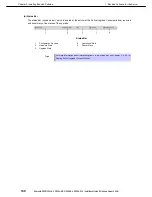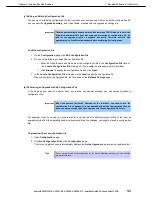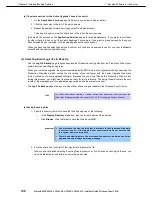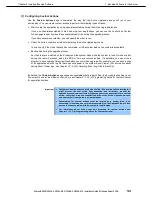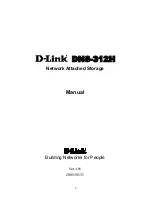
1. Bundled Software for the Server
Express5800/R320c-E4, R320c-M4, R320d-E4, R320d-M4 Installation Guide (Windows Server 2008)
149
Chapter 2 Installing Bundled Software
(7) Configuring Custom Actions
Use the
Custom Actions
page to customize the way that the Active Upgrade process will run in your
environment. You can create custom actions to perform the following types of tasks:
•
Start or stop the application by using special executables during the Active Upgrade process.
If you use special executables to start and stop your applications, you can use the controls on Custom
Actions page to specify when these executables will run during the upgrade process.
If you have several executables, you can specify the order to run.
•
Check if a certain condition exists before starting the Active Upgrade process.
You can verify if the critical backup has completed, or if the system load on the system is acceptable.
•
Backup files during the upgrade process.
Any files that are modified on the Production Side system disks while the system is in split mode are lost
during the commit process, when the RDR mirrors are resynchronized. If applicable, you can write a
program to save copies of important files before you commit an upgrade. For example, you can save a copy
of an application-specific log file that does not appear in the system Event Viewer. (For information about
saving Event Viewer logs, see
Chapter 2 (1.5.3 (6) Selecting Event Log Files to Back Up)
.
By default, the
Custom Actions
page supports executables that are batch files (.bat) or application files (.exe).
If you want to use a Visual Basic script (.vbs), see
Chapter 2 (1.5.3 (8) Programming Notes for Custom Actions)
for special instructions.
Important
•
Custom actions run consecutively when called. If one action fails to terminate, it
might prevent the next action from executing, and, ultimately, prevent the
upgrade process from continuing. When you specify an executable for a custom
action, verify that it runs successfully outside of the Active Upgrade process,
and ensure that it completes in a timely manner.
•
Executables for custom actions must be located on a system disk. If an
executable is located on an external or network disk, the Upgrade Side will lose
access to the executable while the system is in split mode.
•
For information about writing your own programs for custom actions, see
Chapter 2 (1.5.3 (8) Programming Notes for Custom Actions)
.






